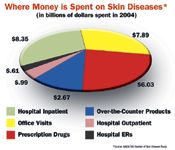- General Dermatology
- Eczema
- Chronic Hand Eczema
- Alopecia
- Aesthetics
- Vitiligo
- COVID-19
- Actinic Keratosis
- Precision Medicine and Biologics
- Rare Disease
- Wound Care
- Rosacea
- Psoriasis
- Psoriatic Arthritis
- Atopic Dermatitis
- Melasma
- NP and PA
- Skin Cancer
- Hidradenitis Suppurativa
- Drug Watch
- Pigmentary Disorders
- Acne
- Pediatric Dermatology
- Practice Management
- Prurigo Nodularis
Article
Skin disease price tag tops $37 billion annually
National report — The first-ever study attempting to assess the total burden of skin disease indicates that the toll exacted from Americans has been underestimated.

The annual price tag for total direct costs and indirect costs such as lost productivity is $37.17 billion, according to a study released jointly by the American Academy of Dermatology (AAD) and the Society for Investigative Dermatology (SID).
"That's a much bigger number than we expected," says Kevin D. Cooper, M.D., SID president. "And that's just on the 21 skin diseases that were chosen for study" based on factors including availability and quality of data.

The top five According to the study, last year Americans spent $22.46 billion on just five skin disorders - skin ulcers and wounds, melanoma, nonmelanoma skin cancer, atopic dermatitis and acne. Skin ulcers and wounds topped this, with direct costs totaling $9.5 billion.
"Skin disease is on the rise," Dr. Cooper says. "It's one of the top groups of medical conditions in which spending grew the most during the past decade (Thorpe KE et al. Health Affairs 2004;22(2):W4-437-445)."
AAD President Clay J. Cockerell, M.D., says he "wasn't a bit surprised" by the findings. "But many people tend to lose sight of the cumulative cost of (chronic) skin diseases over a lifetime, which can reach hundreds of thousands of dollars."
The study additionally found that intangible costs associated with skin diseases' impact on quality of life totaled $52 billion. In this analysis, hair and nail disorders ranked first ($17.3 billion), followed by acne ($11.9 billion) and actinic keratosis ($5.8 billion).
Interpretation needed As with any study, the research requires some interpretation.
"The strength of the study lies in the fact that it was done," says David J. Margolis, M.D., Ph.D., associate professor of dermatology and epidemiology, University of Pennsylvania, and an adviser on the study. "A study like this hasn't been accomplished in the past."
"The researchers used a consistent approach to look at all 21 disease groups studied," he says. "And they used well-known data sets" for incidence data.
However, Dr. Cockerell says one potential weakness is that researchers analyzed only 21 diseases out of more than 3,000 varieties of skin disease that have been identified.
"The study really only addresses one aspect of burden, which is cost," Dr. Margolis adds. "It doesn't address psychological and social difficulties. Another weakness is that it's only as good as the data that was out there. And a lot of this data is based on global assessments of healthcare problems, not necessarily on evaluating everybody and costing out the true burden on an individual level, which, unfortunately, is hardly ever done in any study."






